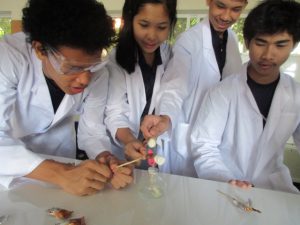Have you ever make s’more? If yes, that is great; however, do you know how to use s’more to teach others about limiting and excess reactants?
As part of our unit two topics vary from lewis structure to VSEPR model to polarity to types of bonding, we did a lab to further our understanding of limiting reactant and percent yield, which means the substance that gets used up in a chemical reaction and the percent ratio of actual yield to the theoretical yield respectively.
In this lab, I was working with three other boys, and we were given eight pieces of crackers, five marshmallows, and 12 pieces of chocolate candies. Following the procedure, we had to make four s’mores in which each contains two pieces of crackers, one marshmallow, and three pieces of candies. Hence, we can see that the candies and the crackers are the limiting and the marshmallows are the excess reactant because there is one marshmallow left over after preparing each s’more .
After determining which reactant is excess and which is limiting, we calculated the total weight of one s’more before and after roasting the marshmallow and the chocolate. The before-roasting calculation is going to be our theoretical yield whereas the after-roasting weight is the actual yield. Since we have both the actual and theoretical yield, we can easily find the percent yield by taking actual yield divided by the theoretical yield and multiplied by 100.
For me, I enjoyed not only assembling s’more but also working in a team that is full of boys and weighing and calculating the percent yield. It was my first time to make and eat s’more, and I love it! Can you find the percent yield of your favorite food?



